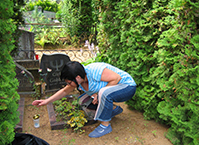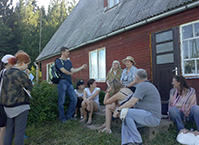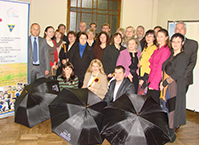About kindling of the furnace in potter's craft
Categories: Study and work, Peteris Gailums
Story-teller: “So, and it is stoked there, from that side, in front at the lower end there is the furnace, lower, lower, lower, err, the furnace is at the lower end. But in the beginning that firewood is not put here at the bottom, into the furnace, under the kiln or into the kiln, instead, it is burned there outside. At first..”
Interviewer: “By the kiln?”
Story-teller: “By the kiln. At first, some three or four billets are burned and thus the warmth gets into. And then, after a half an hour, there are already five or six billets, you add gradually. If the firewood was put there all at once and the fire kindled there at the bottom, all the pots would break into pieces. And that is a very important, sophisticated moment how to heat it. If the kiln is not preheated, pots will crack and break. The transition should not be very fast. It should be very very gradual. After two hours, there is a little inside, after four – five hours it is heated inside, right under the pots. And, then after eight – nine hours, all the pots inside are red, all the shards are red and fire appears above the kiln a little. But after ten – twelve hours, the fire goes so much above the kiln, in the height of about a metre and a half. And inside, exactly in the final stage, the temperature might be about a thousand, thousand fifty, thousand and a hundred degrees. So you can imagine what the heat is in there.”
Interviewer: “No, we cannot!”
Story-teller: “Can’t you? Then you should come right when the kiln is stoked to understand that, heh, to understand all that. And, of course, if inside the temperature is a thousand degrees, then the stoker also does not feel cold. That is why I am so slim, because all the fat has gone out because of the heat. And the stoking goes on, the whole process takes twelve-fourteen hours without interruption. In every five or ten minutes, I add some firewood. All the time, all those hours. To stoke one such kiln, I use almost all the firewood that is prepared here, that is here, behind, almost all, maybe, a little would be left but not much. And…”
Interviewer: “And the wood is important!”
Story-teller: “It is! Very important! Only spruce and pine are used. First, because, if one stoked using deciduous trees, the furnace would be full of coal in a couple of hours, there would be no place for firewood anymore. That’s because deciduous trees produce coal, while coniferous trees burn practically to ashes every time. And when the kiln has been stoked, I mean, before the next stoking, there are just some pails of aches after the whole stoking. This is one reason! The other reason is that the temperature of coniferous trees is the same in the very firewood and at the top of the flame. Therefore it all burns evenly. As to deciduous trees, the greatest heat is right at the coal, at the firewood. This is the other precondition. And, I could say, that kilns of this kind are unique. They are unique, firstly, because the very construction of the kiln has not changed since the 20s-30s of the previous century. The kilns of this type were used for stoking by Paulāns, Vilcāns, Čerņavskis, Ušpelis… Only their kilns might have been bigger or wider or longer, but the idea, how, how everything happens, has not changed. This is one thing. The other reason why it is unique is that, when I put something into the kiln, I glaze one pot green, another – blue, one more – yellow and one more – brown. But I never know what I’ll get in the end! I don’t know that! Because the result depends on the phase of the moon, the atmospheric pressure, the fire, the smoke and, finally, God. And every kiln is slightly different. And not only kilns are different – one pot can have one slight shade of colour on one side and the other on the other side. That is, where, where there is more fire, and, and, the rest. And, of course, there is no thermometer! The temperature should not be less or more than necessary. And, if, let’s say, there is not enough fire, the glaze would not melt, the pottery would not look good, it would not be beautiful. The crocks are not glossy, if it is a glazed kiln, that glaze has not melted. If there is too much fire, I mean, I have put too much firewood into the kiln at a time, in all that long time! If, from such a pot it becomes like this, it means that, not in the whole kiln, but in one place there has been too much fire that not only the glaze has melted, but also the clay has started to melt. It means that the temperature should have been a thousand and two hundred, two hundred-fifty degrees. Every type of clay has its own temperature of melting: the more red it is, let’s say, clay, the lower its temperature of melting. The colour of clay depends on how much iron oxide it contains. Earlier, earlier it was very easy to state. There was clay from Lode, Lode bricks and there were Kalnciems bricks, such a comparison. Lode bricks were bright bright red, i.e. they contained very very much of iron oxide, while those form Kalnciems were yellowish, i.e. they almost did not contain iron oxide. And, the more iron oxide, the less temperature it endures. So, and we stopped at the question how to determine the temperature precisely. One, that is, who sees closer, one brick, one brick can be pulled out and there in the front is the other such brick that can be pulled out. And, after some nine – ten hours, if earlier, there is no need to do that earlier, I pull that brick out and look into. Everything is seen because inside it is as bright as day! If the dishes shine, it means that the necessary temperature has been achieved, the glaze has melted. If they are not glossy, then one should go on stoking. In such a way, I check exactly those lower dishes. One more way, which is also used to check, the first flame that appears above the kiln, let’s say, after nine hours, burns as in a campfire, it is orange, yellowish or red. But when it reaches the temperature of thousand degrees, the flame becomes transparent, maybe some of you have seen, when they weld using gas, it looks like that. That flame is almost, practically invisible. And here it is the same. The temperature inside is so high that the flame is almost invisible. That also is an indicator, the flame becomes bluish violet, and that also is an indicator that the necessary temperature has been reached in the kiln and those pots have been glazed, they are ready. And then there are other subtleties, but anyway it is impossible to envisage everything for certain. And what else, else influences is that somewhere here there is an underground water stream, and in this corner the same, the same glaze in that corner will be brown, yellowish brown, in this it will be greenish, greenish brown. So it is influenced by some natural process, the nature also influences.
Thus it happens so that, that all the process, the day before stoking I try to put all those pots, but not always I manage to place them, that would be ideal if I could, and then, in the morning, I kindle the kiln and then stoke it. And, when the temperature is reached, I stop stoking and go to bed. I can’t sleep in the morning, I want to see what the result is. Every time it is like this.”
Images
Audio
Researcher: Dr. philol. Gatis Ozoliņš, Daugavpils Universitāte













